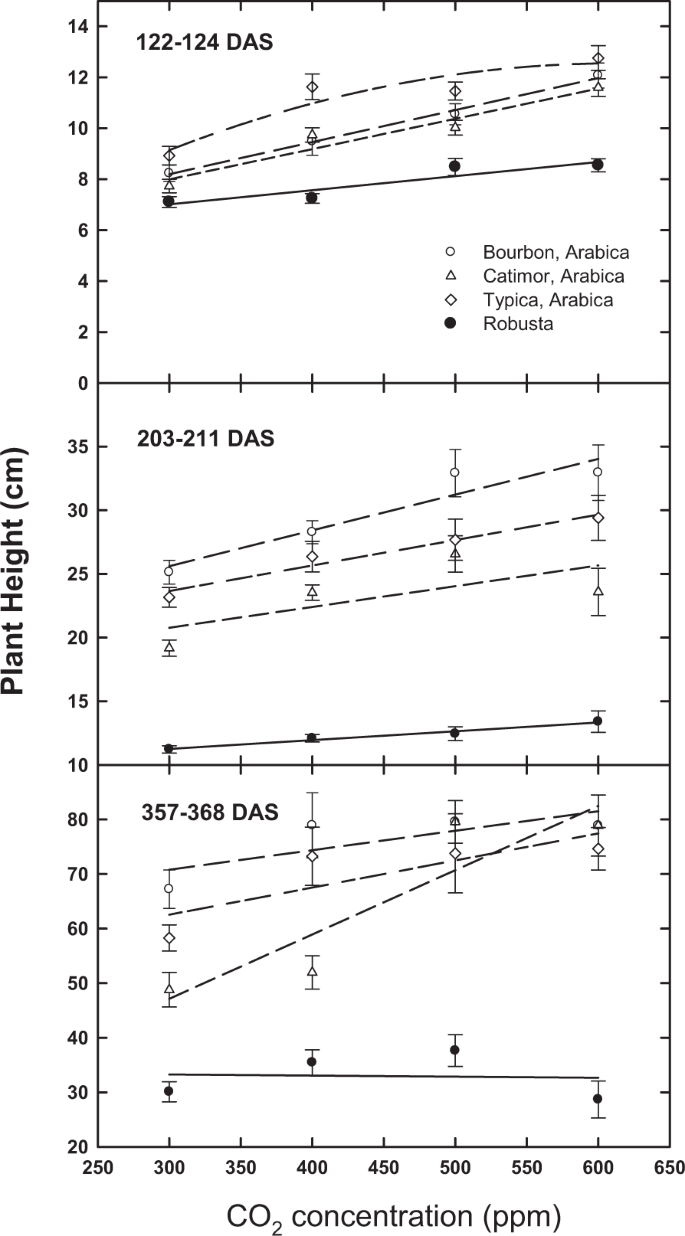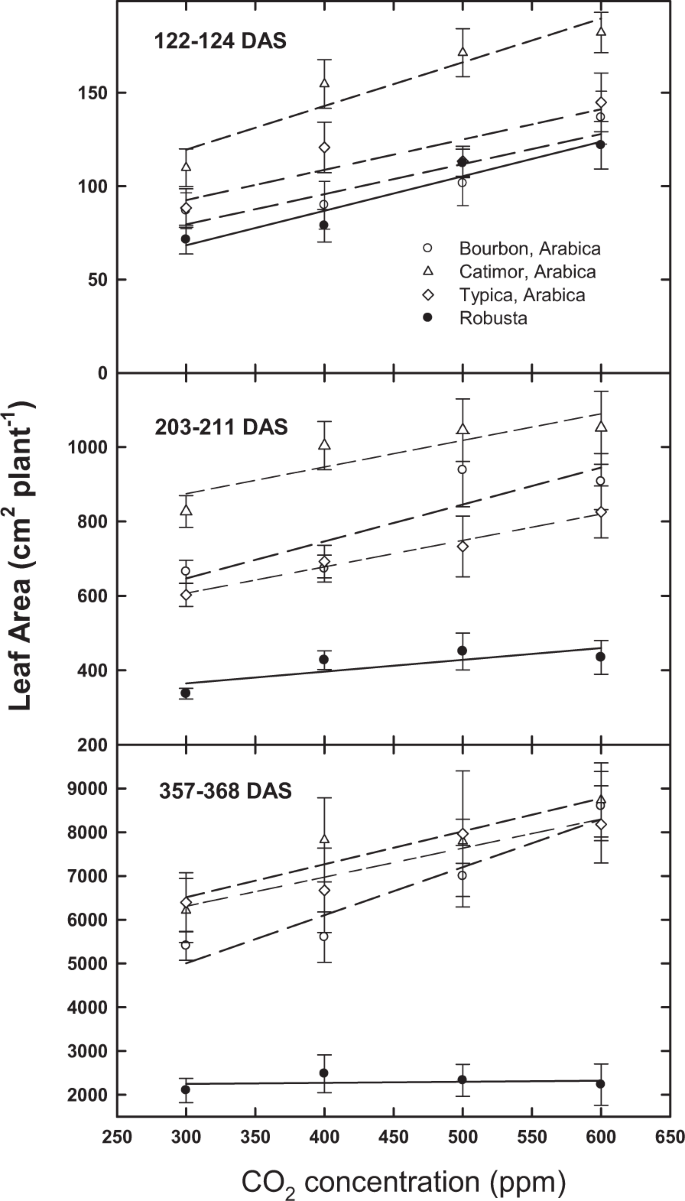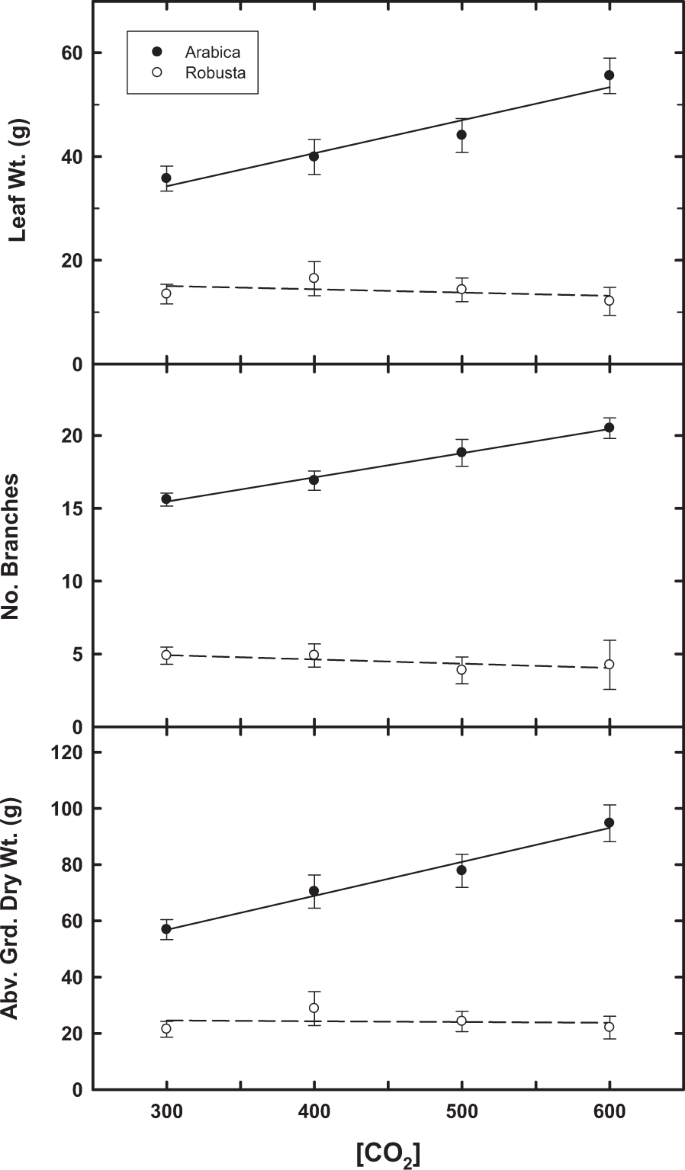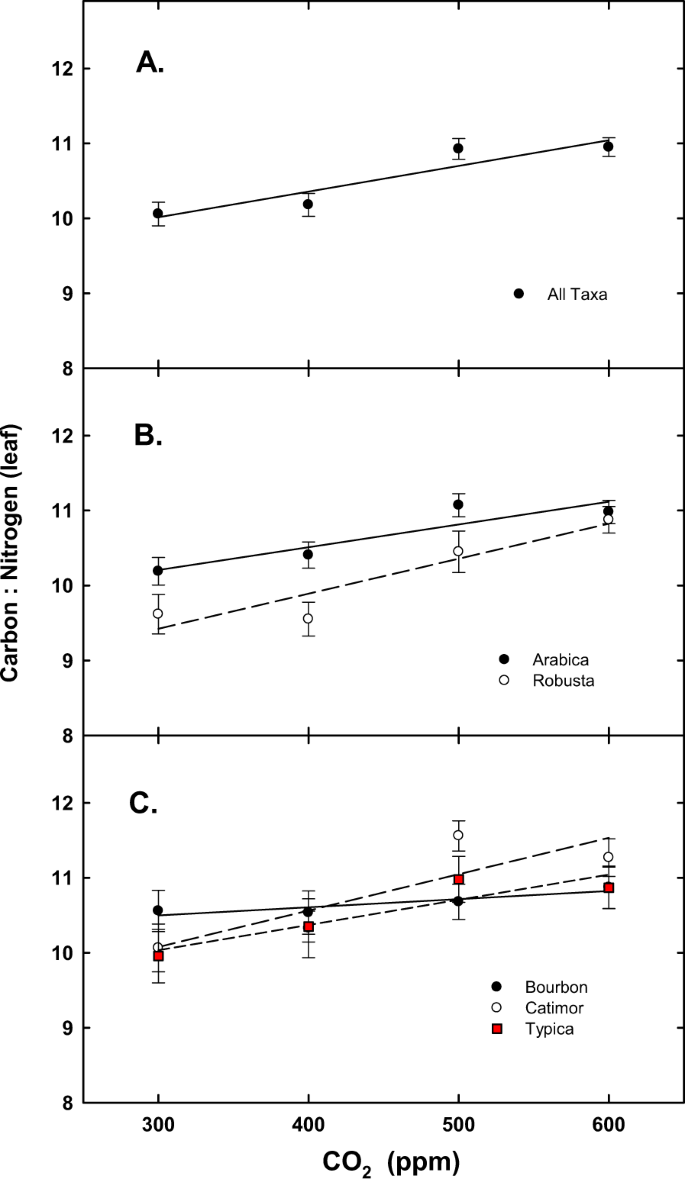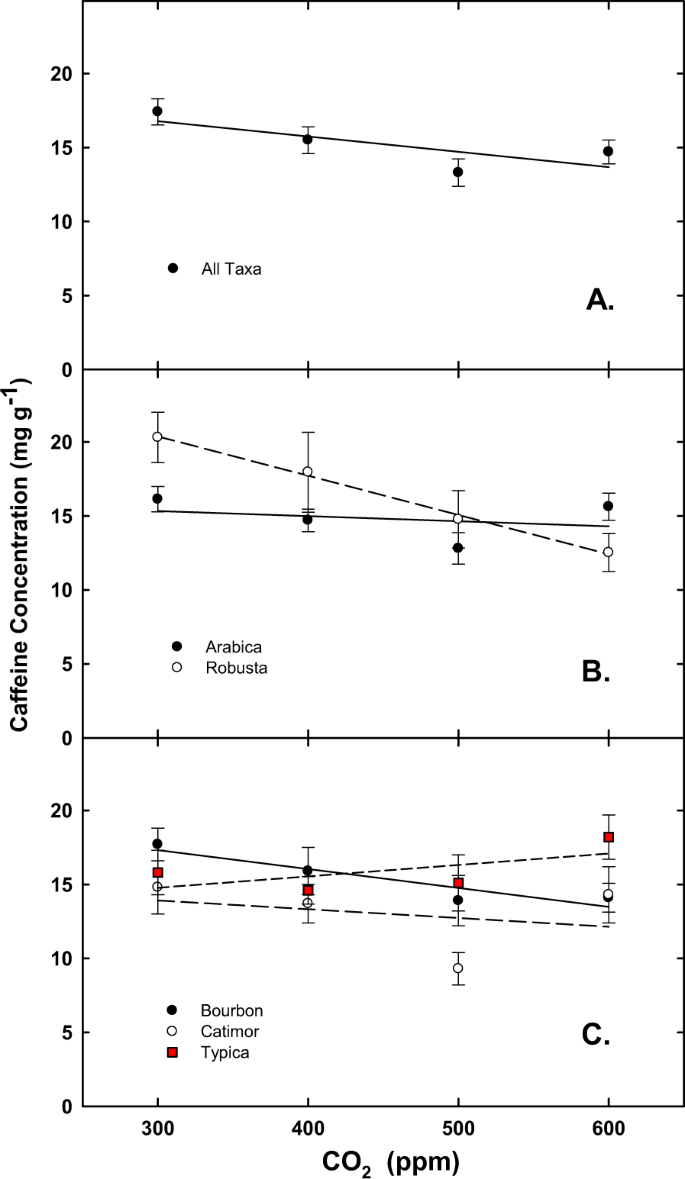Early growth phase and caffeine content response to recent and projected increases in atmospheric carbon dioxide in coffee (Coffea arabica and C. canephora)
Abstract
Introduction
Results
Discussion
Methods
Seeds
Three Arabica cultivars widely grown throughout Latin America were tested: cv. ‘Bourbon’, cv. ‘Catimor’, and cv. ‘Typica’52,53. Typica and Bourbon are the progenitors of most Arabica coffee cultivars grown worldwide and are believed to have originated from coffee grown in Yemen of Ethiopian origin54,55. Arabica coffee grown in Indonesia originated from Yemen, and seeds taken from Java (Indonesia) to Amsterdam and then to the American continent led to the denomination Typica53. Seeds taken from Yemen and grown in Île de Bourbon (Bourbon Island; present day La Réunion) led to the denomination Bourbon18. Catimor is the result of crossing of two coffee cultivars: cv. ‘Caturra’ and cv. ‘Híbrido de Timor’ or ‘Timor Hybrid’ (a natural polyploid hybrid originating in Timor, an island in the Malay Archipelago, and resulting from a crossing between Arabica and robusta). Híbrido de Timor and the derived Catimor are resistant to coffee leaf rust (Hemileia vastatrix) and gained their resistance genes from robusta coffee52,53. Mature coffee fruits for the Arabica cultivars were collected in August 2016, and again in September 2017 from plants at Rancho El Porvenir (869 masl; N 15.13229, W 92.20151) in Chiapas, Mexico. Robusta has higher levels of caffeine compared to Arabica (ca. 1.7% vs. 1%, respectively)56 and is adapted to growth at lower elevations in Guineo-Congolian forests57 and thus warmer and mostly wetter conditions relative to Arabica, which originates from high altitudes forest in Ethiopia and South Sudan and is adapted to a cooler, more seasonal environment58. Robusta fruits were collected in 2016 and again in 2017 from plants at Ejido Salvador Urbina (693 masl; N 15.04415 W 92.18578) in Chiapas, Mexico. Fruits were depulped, fermented, washed, and dried (ca. 12% moisture) and sent to the USDA-ARS Beltsville laboratory for germination.Planting
Twelve plastic bins measuring ca. 60 cm × 50 cm × 33 cm deep (ca. 99 L by volume) were used to provide three monocultures of the four (three Arabica and one robusta) taxa for each [CO2] treatment (four chambers). Each bin was perforated with 12 holes (1 cm diam.) to allow for water drainage. A screen mesh was placed at the bottom of each bin prior to adding the growing medium (Pro-Mix BX; Premier Horticulture Inc., Quakertown, CA, USA) to minimize growing medium loss after watering. Seeds were soaked in water 24 h prior to planting, to promote germination. Each bin was moistened before planting 72 seeds per tub, ca. 2.5 cm deep, and ca. 5 cm apart. For the first run, seeds were planted on August 10, 2016 and the first germination occurred on September 5, 2016. For the second run, seeds were planted on September 12, 2017 and the first germination occurred on October 11, 2017. Rates of germination did not vary as a function of [CO2]. For both trials, nutrients were initially provided at sowing and again at two months post-planting using a complete nutrient solution59. MiracleGro 24-8-16 (Marysville, OH) was provided at ca. 3 months following planting and given at 2–3 weeks’ intervals until final harvest. An iron chelate micronutrient (Sprint 330, Becker Underwood, Ames, IA, USA) was sprayed as needed. The growth medium/soil was maintained at, or close to, field capacity.Environmental chambers
Providing pre-ambient [CO2] concentrations is not possible in situ; therefore, controlled environment chambers (Bio-Chambers, Incorporated, Winnipeg, Canada) were used. The temperature for each chamber was kept constant at 25 °C, day/night. Light, quantified as photosynthetically active radiation (PAR), was maintained at 400 µmol mol−1. The daily light period was 12 h light was supplied by height-adjustable, dimmable banks of metal halide and high-pressure sodium bulbs (400 µmol m−2 s−1). CO2 concentrations were maintained by injection of either CO2 or CO2-free air using a TC-2 controller that monitors [CO2] in real time as measured by an infrared gas maintained in absolute mode. To maintain a range of recent and projected atmospheric CO2, concentrations were set at 300, 400, 500 and 600 ppm, 24 h day−1. These [CO2] values represent the measured Mauna Loa values from 1915 to 2015, and those projected by the end of the current century60. Actual mean [CO2] values (+SD, in [ppm]), from measurements recorded every three minutes throughout the experiments in each of the chambers, were 326 ± 38.6, 430 ± 42.7, 511 ± 26.2, and 607 ± 27.9 in the first run, and 303 ± 23.2, 409 ± 29.6, 499 ± 20.4, and 596 ± 23.0 in the second run.Harvests
Destructive harvests were performed at three different times, ca. 4, 7, and 12 months post-planting. At each harvest, 3–5 plants within a bin (for all taxa and [CO2] treatments) were removed from the tubs, height determined (cm), then separated into leaf laminae, branches, stems, and roots. Leaf (cm2) area was determined photometrically using a leaf area meter (Li-Cor 3100, Lincoln, NE, USA). All plant material was weighed (g) after drying at 65 °C until dry weight was constant. Root binding did not occur as indicated by visual examination at the conclusion of the experiment when plants were removed from tubs.C:N ratios and caffeine analysis
For each sample, all leaves, per plant were pooled and oven-dried (65 °C) until the sample was completely dry. Each dried sample was ground using a Wiley Mill with a mesh size #20. Total C and N contents were determined using a Vario Max CN (Elementary Americas, Inc., Ronkonkoma, NY, USA). Nitrogen and carbon content were determined as a percentage of the dry weight of the sample. For extraction and determination of caffeine, leaves within a replicate were flash frozen in liquid N and stored at −80 °C until lyophilized. Leaves were then pulverized using an A11 Basic Analytical Mill (IKA Works Inc., Wilmington, NC, USA). A total of 100 mg of pulverized leaf material was added into 15 ml centrifuge tubes with 5.0 mL of a 70% methanol/water mixture. Tubes were then vortexed for 30 s and sonicated for 60 min. The slurry was centrifuged at 5,000 rpm for 10 min before being diluted (1:20), filtered, and ultimately stored in 1.5 mL HPLC vials. All reagents used for the analysis were of HPLC grade purity and prepared fresh on each day of the analysis. Instrumental analysis was performed using a Shimadzu Prominence High Performance Liquid Chromatograph (Shimadzu Scientific Instruments, Columbia, MD, USA) using a mobile phase of 80% methanol/water and 15 mM phosphate buffer at pH 6.2. Separation was conducted using a Thermo Scientific Aquasil reverse phase C18 column (4.6 × 250 mm, 5 µm particle size; Thermo Fisher Scientific, Waltham, MA, USA) at a flow rate of 0.550 ml/min. Detection and quantification was done using a UV detector at 275 nm and determined using a calibration curve. The caffeine calibration curve was created using an HPLC grade caffeine standard (99.7% purity; ACROS Organics #10816-5000; Thermo Fisher Scientific, Waltham, MA, USA) across five concentrations 2.5, 5, 10, 20, and 25 ppm. The fitted curve showed excellent linear responsivity as demonstrated by an r2 of 0.998. In addition, there was negligible variation between replicate injections at 10 ppm using the same standard as measured by its percent relative standard deviation of 0.385%. The caffeine concentration in leaves can also be used as a proxy for concentrations in coffee beans, based on a correlation between caffeine concentration in seedling leaves and seeds61,62. Dias Chaves et al.61 focused on the 1st and 3rd pair of leaves in the seedlings, while de Moraes et al.62 used the 3rd and 4th pair. We found no significant differences in caffeine content between the last pair of fully expanded leaves and all remaining leaves combined (cotyledons excluded; using March 2017 samples, i.e., first year, second sampling; 7 months and 18 days post-planting). Based on these results, we pooled all leaves at each sampling date for caffeine analysis. Mazzafera and Magalhães63 found no correlation between leaves and seeds, but these were collected from mature plants, not seedlings.Statistical analysis
Three replicate bins for each Arabica cultivar and for robusta coffee (i.e., 12 bins per chamber) were present for each of four [CO2] treatments. Within each chamber [CO2], bins were randomized; and randomized again after the first two harvests at 4 and 7 months to avoid edge effects. After the first run of the experiment (i.e., one year), the chambers were randomly reassigned [CO2] treatments and the experiment repeated. Humidity, PAR, and temperature were quantified before and at the end of each harvest to determine within chamber and among chamber variability. Values for each parameter were consistent between experimental runs. All measured parameters were based on tub averages (3–4 plants per tub) for both runs. All measured and calculated parameters were analyzed using analysis of variance including [CO2], Arabica cultivars, Arabica vs. robusta, and harvest time (Statview Software, Cary, NC, USA).References
- 1.
Burton, D. A. 2020. Sea-Level information. https://www.sealevel.info/co2_and_ch4.html.
- 2.
Cure, J. D. & Acock, B. Crop responses to carbon dioxide doubling: a literature survey. Agric. For. Meteorol. 38, 127–145 (1986).
- 3.
Kimball, B. A., Kobayashi, K. & Bindi, M. Responses of agricultural crops to free-air CO2 enrichment. Adv. Agron. 77, 293–368 (2002).
- 4.
Loladze, I. Hidden shift of the ionome of plants exposed to elevated CO2 depletes minerals at the base of human nutrition. elife 3, e02245 (2014).
- 5.
Gamage, D. et al. New insights into the cellular mechanisms of plant growth at elevated atmospheric carbon dioxide concentrations. Plant, Cell Environ. 41, 1233–1246 (2018).
- 6.
Bertolino, L. T., Caine, R. S. & Gray, J. E. Impact of stomatal density and morphology on water-use efficiency in a changing world. Front. Plant Sci. 10, 225 (2019).
- 7.
Ahmed, F. E., Hall, A. E. & Madore, M. A. Interactive effects of high temperature and elevated carbon dioxide concentration on cowpea (Vigna unguiculata (L.) Walp.). Plant, Cell Environ. 16, 835–842 (1993).
- 8.
Bunce, J. A. Contrasting responses of seed yield to elevated carbon dioxide under field conditions within Phaseolus vulgaris. Agric., Ecosyst. Environ. 128, 219–224 (2008).
- 9.
Shimono, H. et al. Genotypic variation in rice yield enhancement by elevated CO2 relates to growth before heading, and not to maturity group. J. Exp. Bot. 60, 523–532 (2008).
- 10.
Hasegawa, T. et al. Rice cultivar responses to elevated CO2 at two free-air CO2 enrichment (FACE) sites in Japan. Funct. Plant Biol. 40, 148–59 (2013).
- 11.
Wang, D. R. et al. Evidence for divergence of response in Indica, Japonica, and wild rice to high CO2 × temperature interaction. Global Change Biol. 22, 2620–2632 (2016).
- 12.
Ziska, L. H., Morris, C. F. & Goins, E. W. Quantitative and qualitative evaluation of selected wheat varieties released since 1903 to increasing atmospheric carbon dioxide: can yield sensitivity to carbon dioxide be a factor in wheat performance? Global Change Biol. 10, 1810–1819 (2004).
- 13.
Bunce, J. Using FACE systems to screen wheat cultivars for yield increases at elevated CO2. Agronomy 7, 20 (2017).
- 14.
Li, Y. et al. Soybean intraspecific genetic variation in response to elevated CO2. Arch. Agron. Soil Sci. 65, 1733–1744 (2019).
- 15.
Osorio, N. The global coffee crisis: a threat to sustainable development. International Coffee Organization, London, http://dev.ico.org/documents/globalcrisise.pdf (2002).
- 16.
Davis, A. P., Chadburn, H., Moat, J., O’Sullivan, R. & Hargreaves, S. E. Nic Lughadha, High extinction risk for wild coffee species and implications for coffee sector sustainability. Sci. Adv. 5, eaav3473 (2019).
- 17.
USDA-FAS, Coffee: world markets and trade. United States Department of Agriculture, Foreign Agricultural Service https://downloads.usda.library.cornell.edu/usda-esmis/files/m900nt40f/xk81jw68v/kp78gs60d/coffee.pdf (June 2019).
- 18.
DaMatta, F. M. et al. Sustained enhancement of photosynthesis in coffee trees grown under free-air CO2 enrichment conditions: disentangling the contributions of stomatal, mesophyll, and biochemical limitations. J. Exp. Bot. 67, 341–352 (2016).
- 19.
Ramalho, J. C. et al. Sustained photosynthetic performance of Coffea spp. under long-term enhanced [CO2]. PLoS ONE 8(12), e82712 (2013).
- 20.
Ramalho, J. C. et al. Can elevated air [CO2] conditions mitigate the predicted warming impact on the quality of coffee bean? Front. Plant Sci. 9, 287 (2018).
- 21.
Martins, L. D., Tomaz, M. A., Lidon, F. C., DaMatta, F. M. & Ramalho, J. C. Combined effects of elevated [CO2] and high temperature on leaf mineral balance in Coffea spp. plants. Clim. Change 126, 365–379 (2014).
- 22.
Rodrigues, W. P. et al. Long-term elevated air [CO2] strengthens photosynthetic functioning and mitigates the impact of supra-optimal temperatures in tropical Coffea arabica and C. canephora species. Global Change Biol. 22, 415–431 (2016).
- 23.
Sakai, H., Hasegawa, T. & Kobayashi, K. Enhancement of rice canopy carbon gain by elevated CO2 is sensitive to growth stage and leaf nitrogen concentration. New Phytol. 170, 321–332 (2006).
- 24.
Cotrufo, M. F., Ineson, P. & Scott, A. Elevated CO2 reduces the nitrogen concentration of plant tissues. Global Change Biol. 4, 43–54 (1998).
- 25.
Pleijel, H., Broberg, M. C., Högy, P. & J. Uddling, P. Nitrogen application is required to realize wheat yield stimulation by elevated CO2 but will not remove the CO2‐induced reduction in grain protein concentration. Global Change Biol. 25, 1868–1876 (2019).
- 26.
Zhu, C. et al. Carbon dioxide (CO2) levels this century will alter the protein, micronutrients, and vitamin content of rice grains with potential health consequences for the poorest rice-dependent countries. Sci. Adv. 4(5), eaaq1012 (2018).
- 27.
Levinson, H. Z. The defensive role of alkaloids in insects and plants. Experientia 32, 408–411 (1976).
- 28.
Nathanson, J. A. Caffeine and related methylxanthines: possible naturally occurring pesticides. Science 226, 184–187 (1984).
- 29.
Vega, F. E., Blackburn, M. B., Kurtzman, C. P. & Dowd, P. F. Identification of a coffee berry borer-associated yeast: does it break down caffeine? Entomol. Exp. Appl. 107, 19–24 (2003).
- 30.
Araque, P., Casanova, H., Ortiz, C., Henao, B. & Peláez, C. Insecticidal activity of caffeine aqueous solutions and caffeine oleate emulsions against Drosophila melanogaster and Hypothenemus hampei. J. Agric. Food Chem. 55, 6918–6922 (2007).
- 31.
Davis, A. P., Gole, T. W., Baena, S. & Moat, J. The impact of climate change on natural populations of Arabica coffee: predicting future trends and identifying priorities. PLoS ONE 7, e47981 (2012).
- 32.
Curtis, P. S., Snow, A. A. & Miller, A. S. Genotype-specific effects of elevated CO2 on fecundity in wild radish (Raphanus raphanistrum). Oecologia 97, 100–105 (1994).
- 33.
Ziska, L. H. et al. Food security and climate change: on the potential to adapt global crop production by active selection to rising atmospheric carbon dioxide. Proc. Roy. Soc. London, Ser. B 279, 4097–4105 (2012).
- 34.
Ainsworth, E. A. & Long, S. P. What have we learned from 15 years of free-air CO2 enrichment (FACE)? A meta-analytic review of the responses of photosynthesis, canopy properties and plant production to rising CO2. New Phytol. 165, 351–371 (2005).
- 35.
Resco de Dios, V., Mereed, T. E., Ferrio, J. P., Tissue, D. T. & Voltas, J. Intraspecific variation in juvenile tree growth under elevated CO2 alone and with O3: a meta-analysis. Tree Physiol. 36, 682–693 (2016).
- 36.
Ainsworth, E. A. The importance of intraspecific variation in tree responses to elevated [CO2]: breeding and management of future forests. Tree Physiol. 36, 679–681 (2016).
- 37.
Aspinwall, M. J. et al. Tissue, photosynthesis and carbon allocation are both important predictors of genotype productivity responses to elevated CO2 in Eucalyptus camaldulensis. Tree Physiol. 38, 1286–1301 (2018).
- 38.
Ziska, L. H. et al. Climate change, carbon dioxide, and pest biology, managing the future: coffee as a case study. Agronomy 8, 152 (2018).
- 39.
Shimono, H. et al. Prescreening in large populations as a tool for identifying elevated CO2-responsive genotypes in plants. Funct. Plant Biol. 46, 1–14 (2019).
- 40.
Otto, S. P. The evolutionary consequences of polyploidy. Cell 131, 452–462 (2007).
- 41.
Krug, C. A. & Mendes, A. J. T. Cytological observations in Coffea IV. J. Genet. 39, 189–203 (1940).
- 42.
Krug, C. A., Carvalho, A. The genetics of Coffea. Adv. Genet. 4, 127–158 (1951).
- 43.
Franco, C. M. Relation between chromosome number and stomata in Coffea. Bot. Gaz. 100, 817–827 (1939).
- 44.
Mishra, M. K. Stomatal characteristics at different ploidy levels in Coffea L. Ann. Bot. 80, 689–692 (1997).
- 45.
Osabe, K. et al. Multiple mechanisms and challenges for the application of allopolyploidy in plants. Int. J. Mol. Sci. 13, 8696–8721 (2012).
- 46.
Comai, L. The advantages and disadvantages of being polyploid. Nat. Rev. Genet. 6, 836–846 (2005).
- 47.
Okamoto, S. et al. Self-compatibility in Brassica napus is caused by independent mutations in S-locus genes. Plant J. 50, 391–400 (2007).
- 48.
Wright, S. I., Kalisz, S. & Slotte, T. Evolutionary consequences of self-fertilization in plants. Proc. R. Soc. B 280, 20130133 (2013).
- 49.
Anthony, F. et al. The origin of cultivated Coffea arabica L. varieties revealed by AFLP and SSR markers. Theor. Appl. Genet. 104, 894–900 (2002).
- 50.
Moat, J. et al. Resilience potential of the Ethiopian coffee sector under climate change. Nat. Plants 3, 17081 (2017).
- 51.
Farooq, M., Wahid, A., Kobayashi, N., Fujita, D. & Basra, S. M. A. Plant drought stress: effects, mechanisms and management. Agron. Sust. Develop. 29, 185–212 (2009).
- 52.
van der Vossen, H. A. M. Coffee selection and breeding, in Coffee. Botany, Biochemistry and Production of Beans and Beverage, Clifford, M. N., Willson, K. C., Eds., pp. 48–96 (Croom Helm, 1985).
- 53.
Wrigley, G. Coffee (Longman Scientific & Technical, 1988).
- 54.
Wellman, F. L. Coffee: Botany, Cultivation, and Utilization (Leonard Hill [Books] Ltd., 1961).
- 55.
Vega, F. E. The rise of coffee. Am. Sci. 96, 138–145 (2008).
- 56.
Ashihara, H. & Suzuki, T. Distribution and biosynthesis of caffeine in plants. Front. Biosci. 9, 1864–1876 (2004).
- 57.
Davis, A. P., Govaerts, R., Bridson, D. M. & Stoffelen, P. An annotated taxonomic conspectus of the genus Coffea (Rubiaceae). Bot. J. Linn. Soc. 152, 465–512 (2006).
- 58.
Davis, A. P. et al. Coffee Atlas of Ethiopia. Royal Botanic Gardens, Kew (2018).
- 59.
Robinson, J. M. Photosynthetic carbon metabolism in leaves and isolated chloroplasts from spinach plants grown under short and intermediate photosynthetic periods. Plant Physiol. 75, 397–409 (1984).
- 60.
National Oceanic and Atmospheric Administration (NOAA). Earth System Research Laboratory, Global Monitoring Division. http://www.esrl.noaa.gov/gmd/ccgg/trends/.
- 61.
Dias Chaves, J. C., Miyazawa, M., de, M., Mesarina Bloch, F. & Yamakami, J. K. Estimativa do teor de cafeína nas sementas de café baseada na sua concentração nas folhas de mudas e de plantas adultas. Acta Scientiarum. Agronomy 26, 287–292 (2004).
- 62.
De Moraes, B. F. X. et al. Correlação entre teor de cafeína em folhas e grãos de café. XIX Congresso de Pos-Graduacao da UFLA, 27 de setembro a 01 de outubro de 2010, 5 pp. (2010).
- 63.
Mazzafera, P. & Magalhães, A. C. Cafeína em folhas e sementes de Coffea e Paracoffea. Rev. Bras. Bot. 14, 157–160 (1991).

